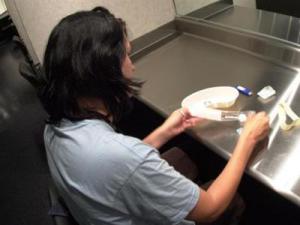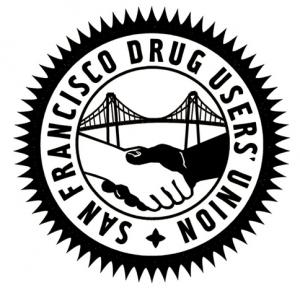The only existing supervised injection site for hard drug users in North America is Vancouver's
Insite, but panelists at a session of the
International Drug Reform Conference in Denver last month said activists in a number of US cities are working to be next. (Plans are also afoot in a couple of Canadian cities.)

client at Vancouver's Insite supervised injection site (vch.ca)
Supervised injection sites (SIS) are
a proven public health and harm reduction intervention that can save lives by preventing overdoses, bring a measure of stability to the sometimes chaotic lives of addicts, reduce the spread of bloodborne infectious diseases such as HIV/AIDS and Hepatitis C, and reduce crime and disorder in the community.
SISs also exist in a number of European countries and Australia, but face both legal and political hurdles in the US. Still, advocates are ready to push the envelope here in a bid to bring the life-, health-, and money-saving innovation here.
Donald Macpherson, executive \director of the
Canadian Drug Policy Coalition and former head of Vancouver's Four Pillars drug policy program explained the prehistory of Insite, offering hints of possible courses of action in the US.
"We had a public health disaster," he said, referring to the city's escalating heroin problem in the 1990s. "Drug users themselves opened an SIS in 1995, and the police watched it, but didn't shut it down. A second opened in 2002. A year later, another non-sanctioned injection site opened up. It was really messy and it took years."
But in the end, Vancouver ended up with Insite and has managed to keep it open despite the best efforts of the Conservative federal government in Ottawa.
"Insite survives because it has an exemption from Canadian drug laws," Macpherson explained. "We won in the British Columbia courts, we won in the Canadian Supreme Court, which instructed the health minister to issue a permit. But we still barely have Insite, and though other cities are working on it, there is a big chill in Canada right now and we're just trying to hang on to what we've got."
Plans for SISs in the US face similar obstacles, but that isn't stopping advocates in a number of cities -- notably Austin, New York City, San Francisco, and Seattle, as well as somewhere in New Mexico -- from pressing forward with plans to open them there.
"I don't know if we'll be first, but we'll be one of many," said Robert Cordero, president and chief program officer of
Boom! Health in the Bronx.
Boom! Health, which resulted from the merger of Bronx AIDS Services and Citiwide Harm Reduction, is a multi-service organization with a three-story building that includes a pharmacy, pharmacists with a harm reduction orientation, and a seven-day-a-week drop in center.
"Safe injection would be embedded with all these other services," he said.
"I don't know if we want to be first, but we want to be one of many," said Olivia Sloan, outreach and education associate for the
Drug Policy Alliance (DPA) in New Mexico, which has been working patiently to bring cutting edge programs like SISs to the state. "We passed harm reduction, including needle exchange, through the state legislature, but it's not working," Sloan said. "We have overdose deaths at four or five times the national average."
Advocates in New Mexico have been and continue to lay the groundwork for SISs, Sloan said.
"We took a political and academic approach, and our conversation about injection facilities started a few years ago," she explained. "We have mobile syringe exchanges. We drafted legislation last year and the Senate passed a memorial to require we study the feasibility of SISs in New Mexico. We have partnered with the University of New Mexico and are looking for a principal investigator."
In San Francisco, preliminary discussions with local officials about SISs have been going on for some time, but the
San Francisco Drug Users Union may follow the path taken by organized Vancouver drug users, as well as many of the needle exchange pioneers in the US, and just do it.
"We have a committee very committed to an SIS that meets every Monday for two hours," said Holly Bradford, the union's coordinator. "We're really on the verge. We have a very active bathroom here; you just open the door," she smiled. We're bringing it to San Francisco," she said. "It might not be sanctioned or aboveground, but it's going to happen."
Whether underground or not, SISs face a hazard-strewn trek. State, local, or federal officials can throw up any number of obstacles, said Lindsay LaSalle, a Berkeley-based law fellow for DPA.
"Drug possession remains illegal and could impact any SIS user, although probably not the staff or operator because they're not handling the drugs," she explained.
"Then there are the crack house laws, which both the federal government and some states have. They make it illegal for anyone to maintain, own, lease, or rent a property where drugs are used, consumed, or manufactured. These laws could cover SISs, and this could impact both clients and staff and operators alike," she elaborated.
"Then there are civil forfeiture statutes. They've used them to go after medical marijuana dispensaries," she enumerated.
Winning local official support reduces some risks, but not all, LaSalle said.
"If SISs were sanctioned at the local level, many of the legal risks dissipate, but state actors could still choose to prosecute," she warned. "In most states, local officers are deputized to enforce state law, so they could still go after an SIS. If authorized at the state level, that would be an incredible victory, but we would still have to deal with the federal government."
While acknowledging that lawyers can be "a buzzkill," LaSalle also hastened to add that things can change faster than we think.
"These legal barriers are not so different from the challenges we've faced with other drug policy issues, like syringe exchanges," she noted. "They were seen as completely radical, but now we have an almost universally accepted public health intervention with the exchanges."
Part of the process of initiating a supervised injection site is selling it to other stakeholders. Panelists had a number of ideas about messages that worked.
"For business people, you tell them this is how we clean up the neighborhood," said a Seattle activist.
"It is a very incremental change from syringe exchange to supervised injection sites," said LaSalle. "Position it as a very small change in an organization that provides all these other services to drug users."
"There's always 'what we're doing is not working,'" said Sloan.
"We're not going to arrest our way out of this problem," suggested Cordero. "But don't go straight to the SIS conversation. Let people see what we're doing, and then they say 'you're doing God's work' and second, 'Holy shit! Where would all those people be if you weren't open?'"
The obstacles to implementing supervised injection sites in the US are formidable, but the need to do so is urgent and increasingly understood, as are the benefits. With activists and advocates in a number of American locales pursuing SISs through a variety of means, the question is not whether it will happen here, but when and where.



